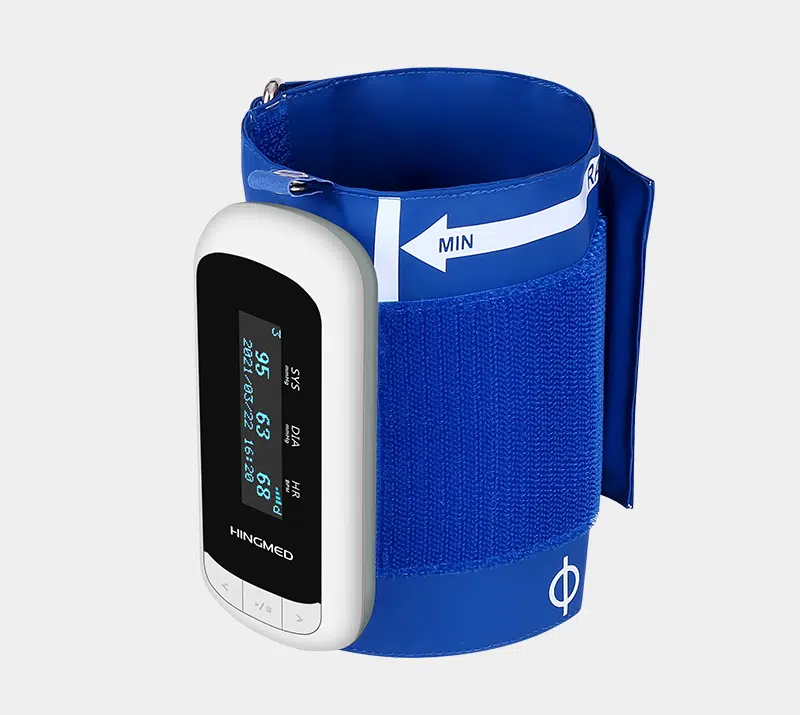In the realm of blood pressure monitoring, precision and consistency are key. Two essential tools for evaluating blood pressure over extended periods are the 24-hour ABPM (Ambulatory Blood Pressure Monitoring) and the Hingmed hospital blood pressure monitor. Each serves a specific role in diagnosing and managing hypertension, and understanding when to use each can greatly impact patient care.
Understanding 24-Hour ABPM
24-hour ABPM is a method of measuring blood pressure over a full 24-hour period while the patient goes about their normal daily activities. This technique provides a comprehensive view of how blood pressure varies throughout the day and night, capturing variations that a single office reading might miss.
Key Features and Benefits:
- Continuous Monitoring: The device, typically worn on a belt with a cuff on the arm, takes readings at regular intervals, often every 15-30 minutes during the day and every 30-60 minutes at night. This continuous data collection helps identify patterns and fluctuations in blood pressure.
- Day-Night Variations: One of the significant advantages of ABPM is its ability to capture the natural diurnal variation of blood pressure, which is essential for diagnosing conditions like white coat syndrome (where blood pressure is elevated in a clinical setting but normal at other times) and masked hypertension (where blood pressure is normal in the clinic but elevated elsewhere).
- Treatment Assessment: ABPM is particularly useful for assessing the effectiveness of antihypertensive treatments and making adjustments based on real-world data rather than isolated readings.
When to Use ABPM:
- Suspected White Coat Hypertension: When a patient’s blood pressure readings are elevated only in a clinical setting but normal outside, ABPM can confirm whether the hypertension is genuinely present.
- Evaluation of Nocturnal Hypertension: For patients suspected of having high blood pressure at night, ABPM provides critical insights into nocturnal blood pressure patterns.
- Treatment Monitoring: It’s used to evaluate the effectiveness of blood pressure medications and make necessary adjustments based on comprehensive, real-world data.
- Diagnostic Clarity: For patients with borderline or inconsistent blood pressure readings, ABPM provides a clearer picture and aids in making a more accurate diagnosis.
The Hingmed Hospital Blood Pressure Monitor
In contrast to ABPM, the Hingmed hospital blood pressure monitor is designed for use in a clinical or hospital setting. This type of monitor is typically used for measuring blood pressure at specific intervals during a patient’s visit or hospitalization.
Key Features and Benefits:
- High Accuracy: Hingmed monitors are calibrated for precise measurements, crucial for accurate diagnosis and treatment in a controlled environment.
- Ease of Use: These monitors are generally easy to use and interpret, providing quick and reliable readings that assist healthcare professionals in making immediate decisions.
- Integration with Hospital Systems: Many hospital-grade monitors, including those from Hingmed, are integrated with electronic health records (EHRs) to ensure that blood pressure data is consistently recorded and easily accessible.
When to Use Hingmed Monitors:
- Initial Diagnosis: Used for initial blood pressure measurements during a patient’s hospital or clinic visit to diagnose hypertension or other cardiovascular conditions.
- Regular Monitoring: Employed for regular monitoring of hospitalized patients to manage blood pressure in acute settings.
- Post-Surgical Monitoring: Essential for tracking blood pressure changes after surgery, where fluctuations can be critical for recovery.
- Medication Adjustment: Helpful for real-time monitoring when adjusting blood pressure medications, allowing for immediate feedback on treatment efficacy.
Comparison and Complementary Use
While 24-hour ABPM and Hingmed hospital blood pressure monitors serve different purposes, they are not mutually exclusive. Each plays a crucial role in the broader scope of blood pressure management:
- 24-hour ABPM provides detailed, long-term insights into blood pressure patterns, which is valuable for diagnosing and managing chronic conditions.
- Hingmed hospital blood pressure monitors offer immediate, high-accuracy measurements in a controlled environment, essential for acute care and initial diagnosis.
Integrating both tools into patient care ensures a comprehensive approach to managing blood pressure. ABPM offers a detailed picture of blood pressure behavior over time, while hospital monitors provide accurate readings during specific medical assessments.
Conclusion
The choice between 24-hour ABPM and Hingmed hospital blood pressure monitors depends on the clinical context and the specific needs of the patient. 24-hour ABPM is invaluable for understanding long-term blood pressure trends and assessing treatment efficacy, while Hingmed hospital monitors are crucial for immediate, precise measurements in a clinical setting. By understanding when and how to use each tool, healthcare providers can offer more accurate diagnoses and effective treatment plans for managing hypertension and other blood pressure-related conditions.




